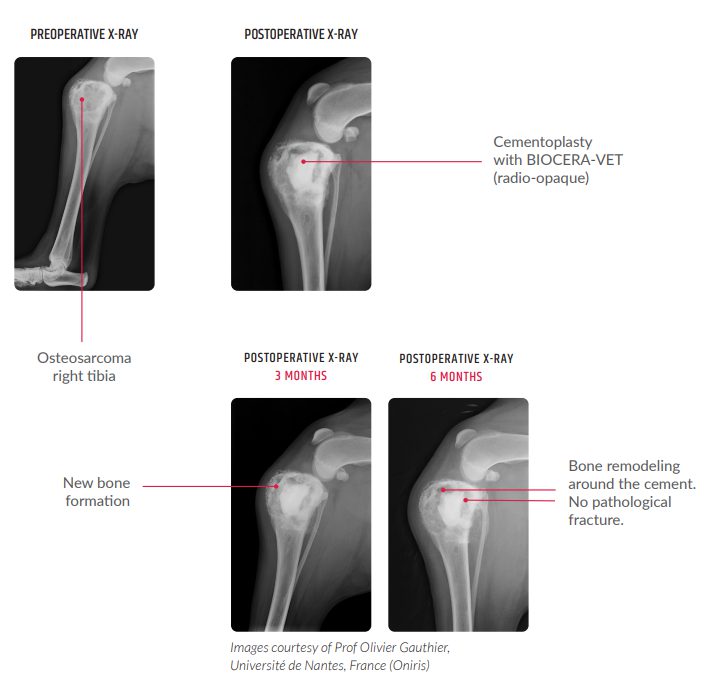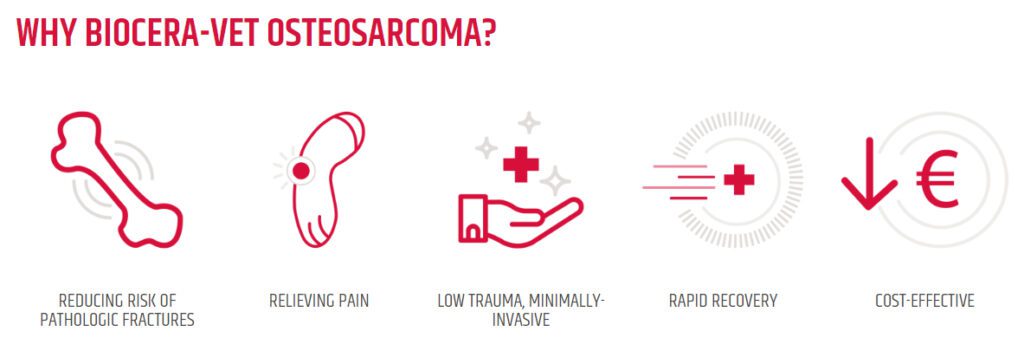If amputation is not an option for your dog or cat, you’ll want to tune in to this episode of Tripawd Talk Radio: Cementoplasty for Osteosarcoma Dogs and Cats.
(UPDATE: as of July 2022, BioceraVet is now in the US. Our friends at The Dog Cancer Blog published this news in January, 20024)
What is Palliative Cementoplasty for Osteosarcoma Dogs and Cats?
Listen or watch the 108th episode of Tripawd Talk Radio. Learn about a new product by TheraVet called BIOCERA-VET® which may be a palliative limb spare option for some dogs with osteosarcoma.
Our guests are Julie Schurgers, Chief Commercial Officer for TheraVet, and Dr. Fanny Guillerminet, two osteoarticular disease experts from TheraVet, a veterinary biotechnology company specializing in osteoarticular treatments for companion animals suffering from joint and bone diseases.
Launched in March in the UK and Ireland, BIOCERA-VET will soon be available is now in North America too. This cementoplasty treatment can be given to dogs with osteosarcoma, as a palliative treatment when amputation is not ideal. BIOCERA-VET is a minimally invasive injection into the affected bone that has been weakened by a tumor.
BIOCERA-VET studies show that it reduces the risk of pathologic fracture, relieves pain and improves patient comfort and quality of life.
Download the Tripawd Talk Podcast
Features of BIOCERA-VET Cementoplasty for Osteosarcoma Dogs
- low-trauma, minimally invasive procedure
- short procedural time – rapid post-operative recovery
- reduced analgesic treatment post-op
- limited costs (compared to amputation)
Tune in as Julie Schurgers and Dr. Guillerminet help us understand the exciting new palliative cementoplasty treatment for osteosarcoma dogs. A complete transcript follows.
Watch and Learn about Cementoplasty for Dogs with Osteosarcoma
Meet Our TheraVet Experts
Julie Schurgers, Chief Commercial Officer for TheraVet
Schurgers works in Belgium where she leads the company’s global efforts to educate the veterinary community about Theravet’s breakthrough orthopedic products that restore mobility and quality of life to animals suffering from debilitating osteoarticular conditions.
Fanny Guillerminet, PhD, Managing Director of TheraVet’s US Operations
Dr. Guillerminet obtained a PhD in the prevention of osteoarticular diseases such as osteoporosis for humans. After more than 10 years of working in biomedical research in Europe and the USA, she joined TheraVet almost ten years ago. She works closely with US veterinary Universities and specialty clinics from her office in Greenville, South Carolina.
More Background Information on Cementoplasty in Dogs
Factors associated with pathological fractures in dogs with appendicular primary bone neoplasia: 84 cases (2007-2013)
Conclusions and clinical relevance: Results suggested that radial primary bone tumors were less likely and lytic tumors were more likely to fracture. The overall incidence of pathological fractures secondary to appendicular primary bone neoplasia in this study with patients treated by means of intensive management for bone pain was higher than previously reported.
Percutaneous cementoplasty in the palliative, multimodal treatment of primary bone tumors of the distal aspect of the radius in four dogs
Conclusions: PC in combination with pamidronate significantly improved lameness in 2 dogs; however, PC is not risk-free. Deep wound infection, intraarticular cement leakage, and venous thrombosis were the main complications.
Transcript: BIOCERA-VET® Palliative Cementoplasty for Osteosarcoma Dogs
What is palliative cementoplasty for osteosarcoma? And how is BIOCERA-VET, helping restore mobility and quality of life to animals suffering from osteoarticular conditions? Find out on this episode of Tripawd Talk Radio.
Tripawds: Thanks for tuning in. You’ll find the video for this 108th episode of Tripawd Talk Radio on the Tripawd’s YouTube channel. You know we always like sharing news about cutting edge treatments when it comes to limb loss for our pets. So, we’re very excited to have two osteoarticular disease experts with us today from TheraVet. That’s the maker of BIOCERA-VET, which is the next generation bone substitute now being used in unique veterinary orthopedic treatments.
Julie Schurgers and Fanny Guillerminet are going to help us understand arthrodesis, corrective osteotomy, palliative cementoplasty for osteosarcoma. And other ways, BIOCERA-VET is helping restore mobility and quality of life to animals suffering from debilitating osteoarticular conditions. Now, that’s a lot to consider. So, let’s get started. Thank you both and welcome to the show.
Julie Schurgers: Hello!
Tripawds: Yes, Thank you so much. Hi, and welcome today. Likewise, likewise. You know, I first heard about all of the treatments that your company does in a press release that came out after a study what– the study results were announced on dogs with osteosarcoma who are treated with BIOCERA-VET. So, we’ll talk about that in a minute, but let me see, Julie, can you give us a little bit of background on the company and how it got involved in the veterinary community?
Julie Schurgers: So, actually, it turns out this is a company that was put up in Belgium a couple of years ago. And the company is developing themselves, producing and developing all kinds of clinical trials specific for medications for dogs and cats with osteoarticular diseases. Osteo means bone and articular means the articulates. So that’s what this term is doing.
Tripawds: And you started a spin-off of technologies from the human medical industry, correct?
From Human Orthopedics to Animal Orthopedics
Julie Schurgers: That’s correct. So actually, our boss, Enrico Bastianelli, his second company is following. So, the first one was bone technology, and it was bone therapeutics, excuse me. And they are still developing bone therapies for humans.
Tripawds: And these are proven successful and human cases, and now we’re applying them to cats and dogs?
Julie Schurgers: Exactly. That’s what we feel because we feel that a lot of pet parents, they really want to treat their dog and cat as best as possible, the longest as possible. And we see that the need for these kinds of therapies is becoming bigger and bigger.
Tripawds: Definitely. And we love that there are– our companies like yours giving us more options when something like osteosarcoma happens. So, the basis of your products is a procedure called, cementoplasty. So, Fanny, can you give us a little bit of background on that? What exactly is it?
What is Cementoplasty?
Fanny Guillerminet: Yes. Once again, cementoplasty is a procedure, which has been developed for human. Nowadays, we’re using that technique, which is commonly used for the human practice for the veterinary field, for the dogs and the cats.
The technique itself, when you have an osteosarcoma that creates a bone cavity inside the bone. And that cavity is going to fragilize the bone in general. So, the patient is going to feel pain, is going to have some limping, and as well as a high risk of what we call pathological fractures. So, pathological fractures, it’s just because the bone is fragilized, you can, well, you can have a fracture.
you’re s. You can while you’re you can have a fracture after that.
The idea here is to fill that bone cavity with a cement. So BIOCERA-VET is a paste, and once it is injected inside the cavity, it’s going to solidify. That going to reinforce the bond, it’s going to provide some bone structure. And that is going to have the dog feeling less pain, first of all, but as well as going to reduce the risk for pathological fracture. It’s going to improve the quality of life in general, and it’s going to reduce the limping of the dog as well.
Tripawds: So, this is not regenerating bone, it’s actually replacing bone in those cavities and strengthening the area where it’s being eaten away, per se?
Fanny Guillerminet: Yes, per se.
Julie Schurgers: Yes. First instance, it’s giving like extra strength to the cavity, as Fanny says. But in later instances, we saw also that the components of BIOCERA-VET are replaced into bone. So we see there’s also some replacement there, but the main effect is like, yeah, the strength.
A New Palliative Treatment Option for Osteosarcoma Bone Tumors in Dogs
Tripawds: That is so exciting, because we have seen a lot of pet parents struggle with a decision to amputate. If their dog is a giant breed dog, they weigh over 100 pounds. They kind of have a feeling that their dog might not do so well on three legs, so they wait a long time to decide whether or not to amputate. I can’t blame them at all.
And then the dog has a fracture, and then they’re forced to amputate or euthanize, and it’s a terrible situation. I love that there’s this option. Before you started using it for osteosarcoma, it was used in other veterinary procedures?
Fanny Guillerminet: BIOCERA-VET is being used currently for two different indications, an indication that we call, add on bone surgeries. This is, for example, when there is a bone surgery, such as TTA or osteotomy. If there’s bone cavities created during the procedure, it can be, the veterinarians can use BIOCERA-VET to as well to reinforce the bone, and is going to use BIOCERA-VET as a bone implant.
BIOCERA-VET is going to help solidifying this area and as well as much an injury is going to little by little being replaced by the natural bone of the patient. The second indication is osteosarcoma, which we’ve been talking about today.
Can Cementoplasty Be Used with Other Osteosarcoma Therapies?
Tripawds: Could this be considered a limb-sparing procedure, which have traditionally been with fixators and mechanical devices?
Julie Schurgers: Actually, I think that all is about to diagnose, which the vet that really has to put like a very good diagnose and looks for the best treatment is. I think it’s important to state that BIOCERA-VET has a very nice effect on the quality of life, but it still remains a palliative effect.
BIOCERA-VET is not treating the cancer. What very often happens is that the vet will make a choice for a combination of different therapies. It will be chemotherapy, or it will be anti-pain medication. Or, an extra surgery, whatever. But now, what the good thing is, is that the BIOCERA-VET, we’re adding an extra option to the treatment of this terrible disease.
Tripawds: Fanny, I’ll throw this question at you. Can this treatment be used in conjunction with, let’s say, radiation therapy and bisphosphonates?
Fanny Guillerminet: Yes, absolutely. So, TheraVet can be used alone, or in addition to any other treatments, like the one you mentioned. It’s really other choice of the veterinarians.
Tripawds: That is really good to know. When did the company realize that it could be used for osteosarcoma?
Clinical Trials Show Lower Incidence of Fractures
Julie Schurgers: As Fanny said already, the cementoplasty, so filling the bone void of someone with cancer is a technique that has been used since in several years in the human environment. There was a vet in France, and he still is, it’s Professor Gucci, from the University of Nord, and he taught about this technique. He has tried it out in a veterinary environment. He’s the one that took the step to transport or transfer this technique from humans to dogs.
Tripawds: There was a clinical trial that went on, where was it done? Can you tell us a little bit more about the trial?
Fanny Guillerminet: The trial was from more than six different clinical sites in Europe, either with private clinics or universities in Europe. Fifteen patients were treated during that trial, and we did find very interesting results.
When we analyze the data at the end of the study (the study duration was six months, by the way), at the end of the study, we show that there was indeed, a bone support provided by BIOCERA-VET of the bone. There was lower incidence of fractures for the patients treated with BIOCERA-VET. As well as orthopedic surgeons reported that there was less pain felt by the patient. And most of all, there was a better quality of life reported by the dog owner.
With Osteosarcoma Pain Management, Too
Case Study: Navy hadcementoplasty with BIOCERA-VET Osteosarcoma in January 2021.
Julie Schurgers: I would like to add something to that, because it’s such a fantastic story. So actually, one of the animals that has been treated, one of the dogs that has been treated by cementoplasty. When he woke up out of the surgery, quite fast, he stood up and he started peeing. And he was being on three legs and one leg up, which was amazing. Because before, the dog was in so much pain that he would never have done that.
So, the effect on pain is really fast. And we see it also in the study, because we have questionnaires also for pet parents, and vets, and we see that the effect on pain is amazing and very fast.
Tripawds: That’s so hopeful, because anybody who’s dealt with osteosarcoma in their dog knows what that limp is like and holding up the paw because they’re in so much pain. So that is super exciting. I’m curious if either you could tell me, were specific dog breeds chosen for the study?
Fanny Guillerminet: No. There was no criteria on the breeds of the patients.
Julie Schurgers: The dogs had osteosarcoma. So actually, it’s more the bigger breeds that are sensitive to that. We’re in that that population.
Tripawds: And Fanny, I understand this is now available at clinics in the United States, correct?
Fanny Guillerminet: No.
Tripawds: Oh! It’s not?
Fanny Guillerminet: Not yet. But we’re working on it. We are planning to commercialize our product in the USA for this coming May. So, in a few months, and that is waiting for us. Yes.
(UPDATE: as of July 2022, BioceraVet is now in the US)
What About Cementoplasty for Cats with Osteosarcoma?
Tripawds: Fantastic. Are there specialized training or specific types of doctors that can do this? Can we learn a little bit more about the actual procedure? Is it surgical to get that in there?
Fanny Guillerminet: A little bit. So, it’s pretty specialized. The procedure itself can be performed by any veterinarians adding some orthopaedic background or surgical medical oncologist as well. It’s still a bit a specialized technique. If any of the listeners today are interested, they could reach to their veterinarians and check with them if they are used to that technique. Or if they would be willing to learn more about that technique.
Tripawds: That’s really, really cool. What about cats? Because we, I know osteosarcoma in cats is super rare, but because we’re such a specialized community, we tend to see it at least a couple times a month. So, do you think there’s plans to try it with cats? Yeah, sure.
Julie Schurgers: Yeah, actually, there is no reason why it shouldn’t work with cats. So, the BIOCERA-VET for bone fractures is used in cats already. We already have several cats that have been included and everything went well. With osteosarcoma, it’s like you say, in cats, it’s much rare, and we don’t have the occasion or the opportunity to test it out. So yes, I think theoretically, it’s possible, but we haven’t had any cases yet.
Tripawds: OK. OK, good to know. Julie, do you think that there will be more trials in the US, or will it just go straight to market in May?
Julie Schurgers: I think that Fanny is best to answer that one. And like now, you are the expert.
Fanny Guillerminet: OK, I’m working on it. Yes. Yes, we are currently actually talking to orthopaedic surgeons here in the USA, as once again, some surgical and medical oncologist. And we have some veterinarians on board with us to do some clinical cases in the USA.
Biocera-VET Coming Soon to North America
Tripawds: Oh, great. Can you tell us where? We often see these things roll out through veterinary teaching hospitals like Colorado State or Davis. Are they getting involved to where people could go and ask about it?
Fanny Guillerminet: So, because it’s not finalized yet and we are in the process, I could not give you any names. There is a lot of, of course, on the big universities are the best to be working with to developing techniques. They have so much support and so much good feedback in the research program, in general. We do work as well with some private clinics, however, that are really fantastic to work with as well.
If there is any, as well, veterinarians listening to us today, feel free to reach out to us if you want to know more about the techniques or even organize some clinical cases for us. That would be fantastic.
Tripawds: This is so exciting, and we hope that everyone learns about this. So that if they’re dealing with osteosarcoma, it’s presented as an option. Thank you so much, Fanny and Julie, for being here. We really appreciate this.
Fanny Guillerminet: Thank you so much for your invitation today. It was a pleasure talking to you.
[End of transcript]



We would love to find where this treatment is available in or near Virginia. Are there any new updates for the cementoplasty?
Stay tuned to the Biocera Vet website for updates about when it will be available in the U.S. or contact TheraVet. We’ll post again as soon as we know more.